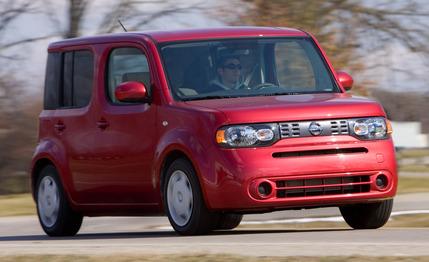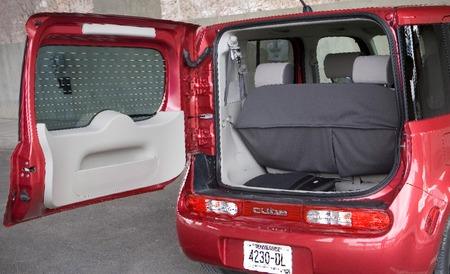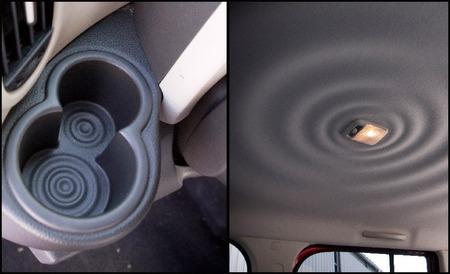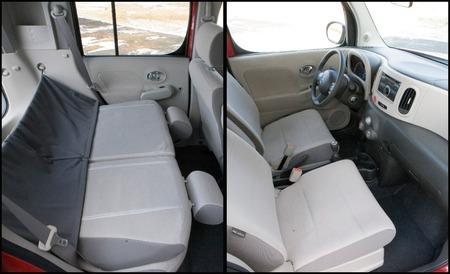
 Road Test
Road Test
In the early 1900s, cubism was the avant-garde movement pioneered by Georges Braque and Pablo Picasso. Sadly, this provocative artistic trend was quickly rendered obsolete by the invention of the cardboard box, an art form later perfected and made affordable by the movement that would become known as Federal Express.
And then, in 1998, Nissan likewise dabbled in cubism with the Cube, curiously keeping it hidden within its own borders—this despite fantastic sales—for fear that Americans might paint the vehicle UPS brown and turn it into a joke for NASCAR fans, who would exhort Dale Jarrett to “Race the Cube, Dale, race the Cube!”
Three generations into the Cube’s existence, it has finally reached our shores, having been beaten to the boxy punch by Honda’s Element, Scion’s xB, and Kia’s Soul. It rides atop a shortened Versa platform—a Versa cubed?—and all four model iterations are front-drive only and fitted with a 122-hp, 1.8-liter four. Alas, we won’t get “e-4WD.” Too pricey, says Nissan.
Speaking of price, it ain’t much, starting at $14,685, which includes stability control and A/C (an iced Cube?). The cost rises as it works its way through the “Ginormous Package”—really—then peaks at $20,815 for a loaded Cube Krōm. Which makes the Krōm, we guess, Cube steak. The top two models eschew the six-speed manual for a CVT identical to the Versa’s.
Dynamically, the Cube is something of a mixed bag. The electric power-assisted steering is delightfully light—your best friend in traffic or while parking—but otherwise feels artificial and reveals little about road textures. Turning radius is a gymnastic 33.4 feet.
_________________________________________________________________


The cargo door swings out, from right to left.
_________________________________________________________________
The engine exhibits no noticeable power peak because there’s no noticeable power. Sixty mph arrives in a leisurely 9.1 seconds versus, say, the 142-horse Kia Soul’s 7.9 seconds. And the Cube’s 17.0-second quarter mile suggests you might want to bring along reading material. Idle quality is superb, save a Poe-like tap-tap-tapping from an unknown source.
_________________________________________________________________


T he 3-D circles in the headliner are unique, as is a cup holder directly in front of a vent.
_________________________________________________________________
The shift linkage is pleasantly swift and fluid for a car so inexpensive. The clutch is light, with predictable takeup. Unlike the Scion xB, the Cube readily steps off with a bare minimum of revs, and the pedals are nicely arrayed for heel-and-toeing. In toto, the drivetrain is surprisingly refined.
Compared with its competitors, the Cube commands the least skidpad grip. In part, that’s due to its 15-inch Toyos—would those be Cubic feet?—and in part because it’s clearly been tuned for a velvety ride. There’s major suspension travel, terrific at coping with frost heaves, potholes, or the occasional dead cow. The downside is plenty of body roll, likely exacerbated by a high center of gravity.
Despite drums at the rear, the brakes are strong, and pedal feel is excellent. And in this econo-container niche, it’s nice to find a sixth gear for freeway slogs. The Cube’s dash, however, occasionally shivers and groans as if it’s twisting, and the vibrating rear headrests—performing a kind of ballroom rumba in the rearview mirror—hint at a platform that isn’t a paradigm of unyielding solidity. The Cube feels fragile. Towing? Not recommended.
The sofa-like front seats are as comfortable as sofas. What they lack in side bolsters is mitigated by deep, wavy stitching that holds your thighs in place. Front headroom, at 42.6 inches, lends the cabin the aura of an aircraft hangar. The rear seats, combined with the dead-flat floor, are equally expansive and would have accommodated two of our website’s six-foot-seven associate editor Jared Galls, although we have only one. Moreover, the rear bench is on rails and slides through six inches of travel. The rear seatbacks fold flat onto the cushions but do not then tumble forward. Note: Stick with the beige and dark-brown interior. The all-black interior is too funereal.
Ergonomically, the Cube is mostly bang on—there’s certainly no mystery surrounding the minimalist HVAC controls—although the fuel-filler release is mounted beside the hood release, in complete darkness, and the side-mirror control is at knee level. Interior surfaces are above average for a car of this price. Visibility is akin to Google Earth’s, and we especially appreciate that bonus pane of glass behind the passenger-side C-pillar, which takes all of the guesswork out of backing up. In fact, the upright windshield is so large that the sun visors resemble ailerons from a Cessna. At freeway speeds, the windscreen displaces a tornado of air, quite audible as it tumbles over the A-pillars. What’s more, the Cube’s slab sides and its stubby, 99.6-inch wheelbase make it susceptible to crosswinds.
_________________________________________________________________


Seats are wide and flat. Rear seatbacks fold down onto the cushions, but the seats do not then tumble forward.
_________________________________________________________________
The cargo door opens easily—it’s light and is fitted with a large, easy-grip handle. Wholly ajar, it offers a 43-inch opening, and there’s a useful detent at the two-foot point, in case you’ve parked close to a car astern.
During World War II, a soldier told Picasso that his cubist paintings were not realistic. Then the soldier showed the artist a snapshot of his girlfriend. “My, my,” said Picasso. “Is she really as small as that?”
Inside, the Cube isn’t as small as that, but neither is it a class winner. Aft of the rear seat, the Cube offers 11 cubic feet of storage, far behind the little Kia Soul’s 19 cubic feet and the Scion xB’s 22. With the rear seat folded, the Cube does surpass the Soul in utility—58 cubic feet versus 53—but both lag behind the Scion xB’s 70. At least Nissan made the most of it, offering 19 sites to hang or store stuff.
Replace one letter in the word Cube, and you’ve got Cute, a quality that needs to be measured out modestly. Check out the ovoid “photo frame” front side windows. Then there’s the headliner’s concentric 3-D rings, which resemble what a satellite sees as it looks down on a Gulf Coast hurricane. The tach is white “to represent the Earth,” says Nissan, while the speedo is blue “to represent the Moon.” And for a few seconds after startup, an orange sun glows warmly between the two gauges, then apocalyptically burns out. Hello, Nostradamus?
The Cube is light, airy, and friendly in all its urban moves but needs to do one thing—anything—way better than its competitors. As it is, its chief claim to fame is looking like a refrigerator from the ’50s. Nissan ought to have joined this cute-box fray when the first xB appeared.